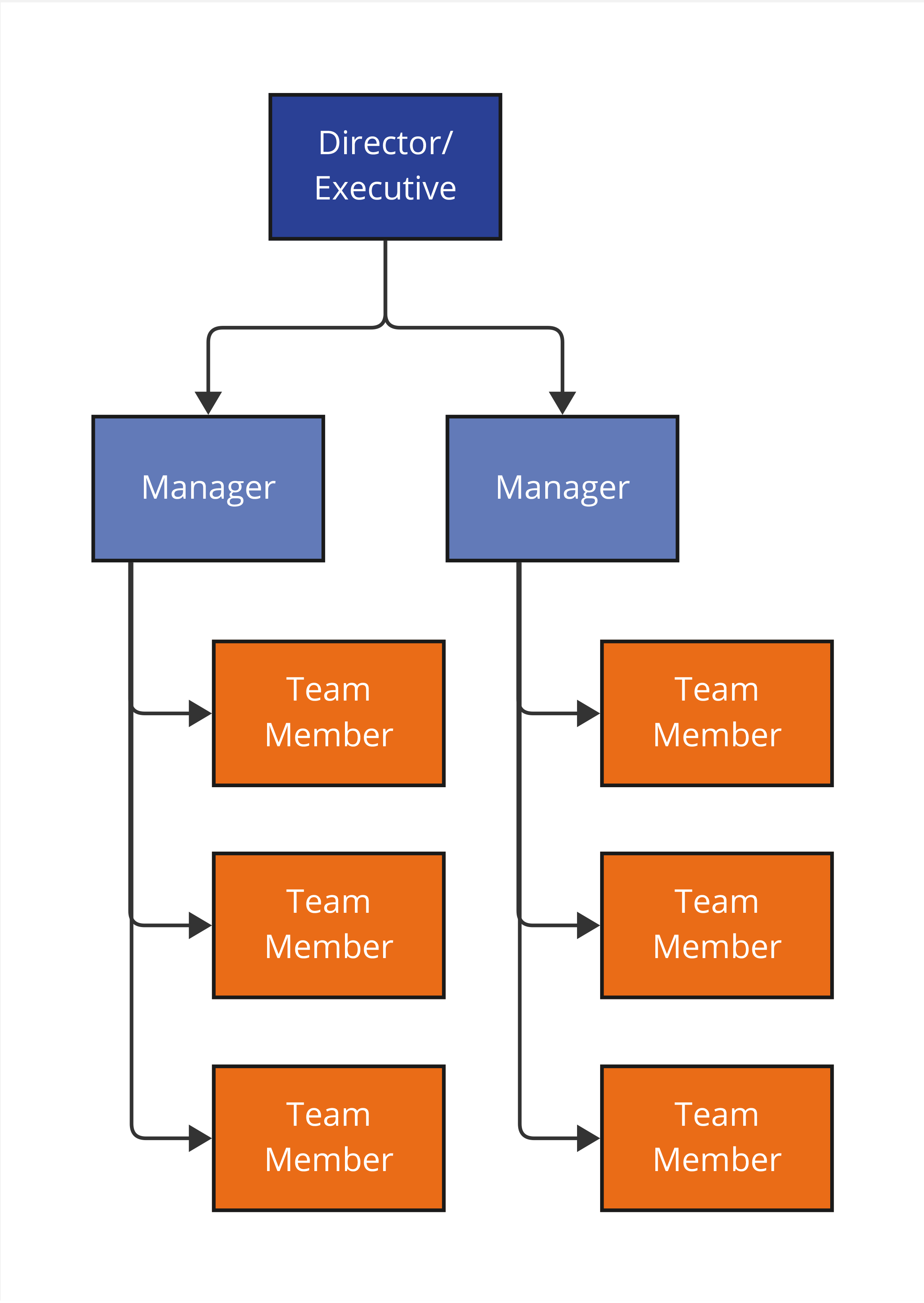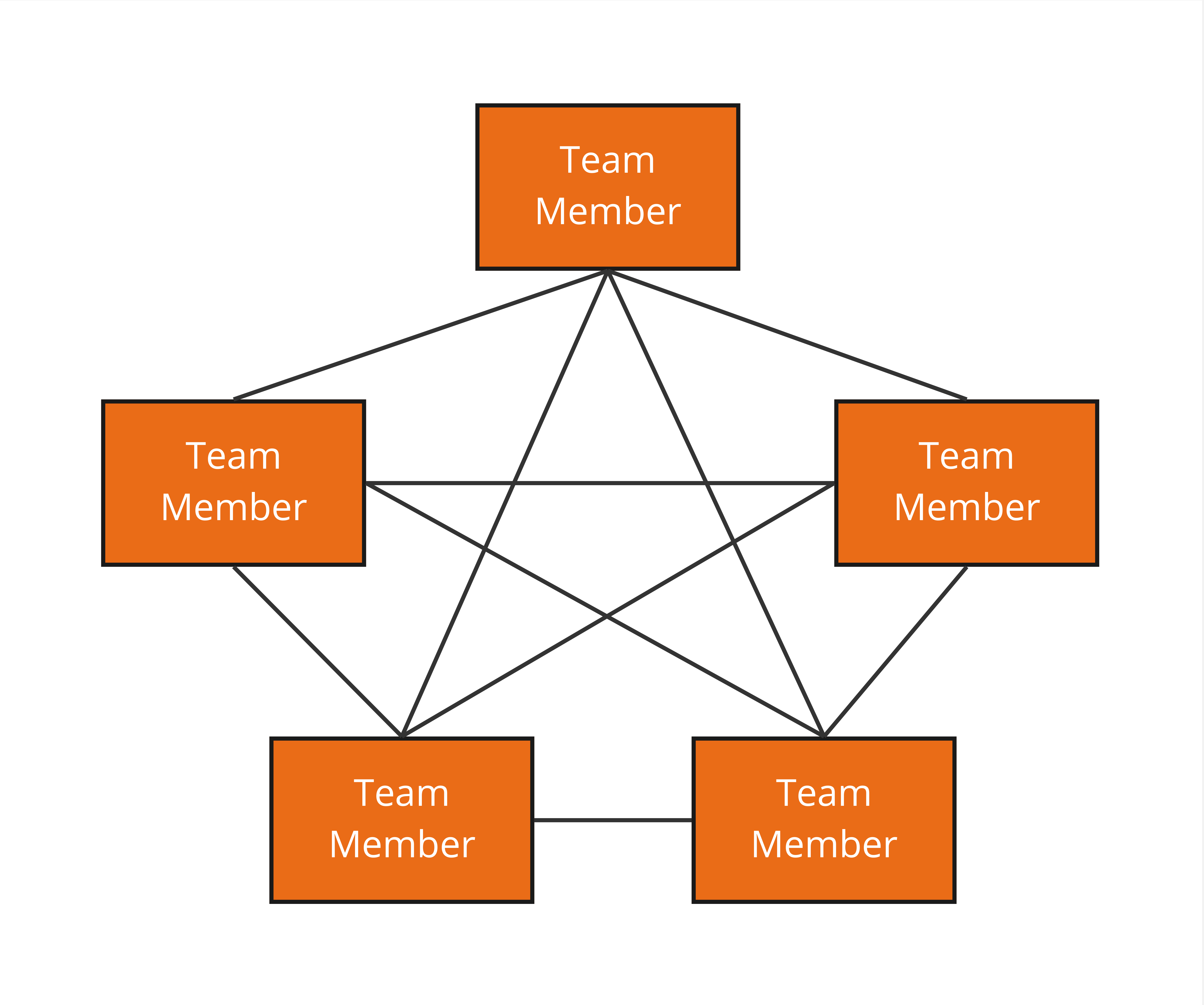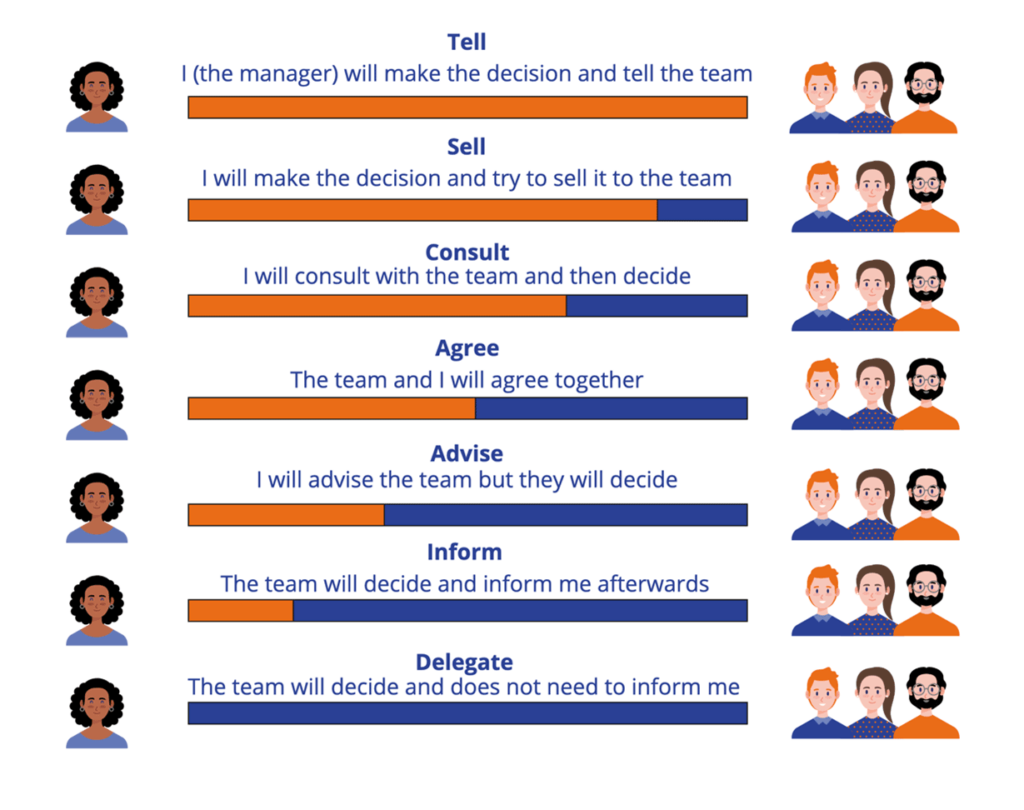In Part 1 of this blog post, I put a new spin on an old set of “commandments” that I learned early in my career. Drawn from a book given to me by a key mentor, those commandments encouraged me to challenge the very hierarchical environment in which I worked.
Our organization structure looked like this:

But we wanted to create an environment where teams could work like this:

Over time, I morphed those commandments into a management philosophy that I believe creates an environment where self-organizing teams can flourish. There are a lot of leaders who simply don’t believe that self-organizing teams can work. A couple of years ago I was introducing agile concepts to a management team at a bank. As we started discussing the concept of self-organization, one of the managers stopped the conversation and told me that it would never work for his team. Naturally, I asked him why.
His response? “If I don’t prioritize their work for them every day, how will they know what to do? And if I don’t stay on top of them, how will I make sure that we meet our deadlines?”
I think many leaders share the same concern. And you can’t flip a switch and change the way a team works overnight. But I’d like to share my “management mantras” with you and provide some insight on how to implement them effectively. Hopefully they’ll help us answer the questions posed by the bank manager.
Kathy’s Management Mantras
1
Hire the very best people you can find.
This may seem really obvious. I can tell you, though, that I’ve been guilty of filling a position with a less than perfect candidate because I tell myself that “I just need someone – I’ve got to get someone to do this work!” Unfortunately, that short-term relief can often come with the long-term consequence of an underperforming team member.
It’s important to note that the definition of the “best” candidate is not something that managers should develop in a vacuum. Remember that you’re trying to create (or maintain) a self-organizing team. A critical perspective on the definition of “best” should come from the team itself. After all – they have a pretty good idea of what they need from a new team member. They’ll also have good insight on how a candidate’s personality will mesh with the rest of the team.
Consider using a Team Competency Matrix to help visualize what is needed from a new team member:

2
Give them the tools and training they need to do their jobs.
Teams can’t achieve their goals if team members – and the team as a whole – don’t have the knowledge and/or tools they need. Looking back at the team competency matrix from the last section… where does the team have gaps?
It can sometimes be difficult to get funding for formal training, but there are many other ways to increase competence in an area. Encourage self-study, coaching from other team members, and even experimentation as channels for learning. Make sure that team members have slack time they can use for self-improvement.
When it comes to tools, budget can again be a factor. Making the team do without the things they need can end up costing huge amounts in terms of productivity; consider that carefully when prioritizing expenditures.
3
Make the mission clear.
I used to joke that some of my fellow managers at a previous company practiced what I called “Management By Wandering About”. They focused on observing what their team members were doing, and when, and where. They frequently interrupted their staff to get updates so they could “stay on top of things”. Unfortunately, a number of their team members were masters of doing lots of work, looking really busy, and accomplishing very little.
Self-organizing teams do best when their leadership focuses on the outcomes needed from the team and ensures that the team is fully aware of those needed outcomes. After all, if I don’t know that there’s a deadline for something, how can I manage my work to meet that deadline? Share the big picture with the team, help them understand their part in it, and clearly outline the deliverables that you need from them. As much as possible, let them determine exactly how to make that happen.
4
Remove obstacles to their success.
Be a resource to help your team remove obstacles. This isn’t to say that you’re responsible for fixing every barrier they face. Sometimes, though, you’re the right person to get the job done quickly.
5
Get the heck out of their way.
Speaking of obstacles, don’t become one yourself!
Don’t require lots of routine reports and communication. Creating those chews up lots of time and typically delivers very little value. Instead, see if you can design “information radiators” that will help the team track its progress while simultaneously giving you a window into what’s happening. Team Kanbans are an excellent example of an information radiator that can do both these things.
Encourage teams to reach out when they need help, but don’t require them to check with you before each step. The Management 3.0 philosophy suggests that there are 7 levels of delegation:

Work with your team to identify decisions that they will frequently need to make. Identify the appropriate delegation level for each of those. Keep in mind that this list isn’t static – items may be added or deleted, and delegation levels may change over time as the team matures or the team’s context changes.
6
Provide “air cover” when things go wrong.
This is generally the hardest mantra to implement. Implementing it means we must accept that our teams will make mistakes. In fact, to really foster a high-performing team, I believe you have to encourage and embrace mistakes.
Early in my career I was interviewing with a potential manager. I don’t remember the exact context, but at one point he told me, “Kathy, if you’re not making mistakes, then you’re not trying hard enough.” That really stuck with me.
Implementing this mantra also means we need to be the ones who take the heat when the team makes a mistake. It can be hard to stand in front of your leadership and say, “Yes, I knew they were doing that, I knew there was a risk, and I chose to accept that risk.” But the first time your throw your team under the bus and let them take the blame is the last time they’ll take a chance on something new.
It’s a Win-Win
As managers, we all know that we look good when our teams succeed. Your teams will not magically morph into high-performing self-organized teams overnight. But with time, patience, and a supportive leadership team, they can get there. And once they do, step back and watch the great things they can do!
–Kathy
PS: If you didn’t catch the first part of this blog post, check it out: The Reality of Organizing a Self-Organizing Team.

Kathy Claycomb
Managing Partner, Lead Expert
Kathy Claycomb brings over 35 years of experience to the classroom. She has participated in all phases of solution development using everything from agile to waterfall methodologies (and quite a few in between). Before joining B2T, her career spanned roles from application developer to Senior Director of Services at various organizations. Kathy has broad industry background including transportation, manufacturing, insurance, energy, healthcare, and banking.
Kathy’s first love is teaching, and throughout her career she has always managed to spend a portion of her time instructing. She has an engaging, highly interactive teaching style that ensures students leave the course with a thorough grasp of the material. Her students consistently praise her teaching abilities and her talent for drawing on her personal experience to enhance their learning.
Kathy served as the Technical Editor for Business Analysis for Dummies, 2nd Edition.

